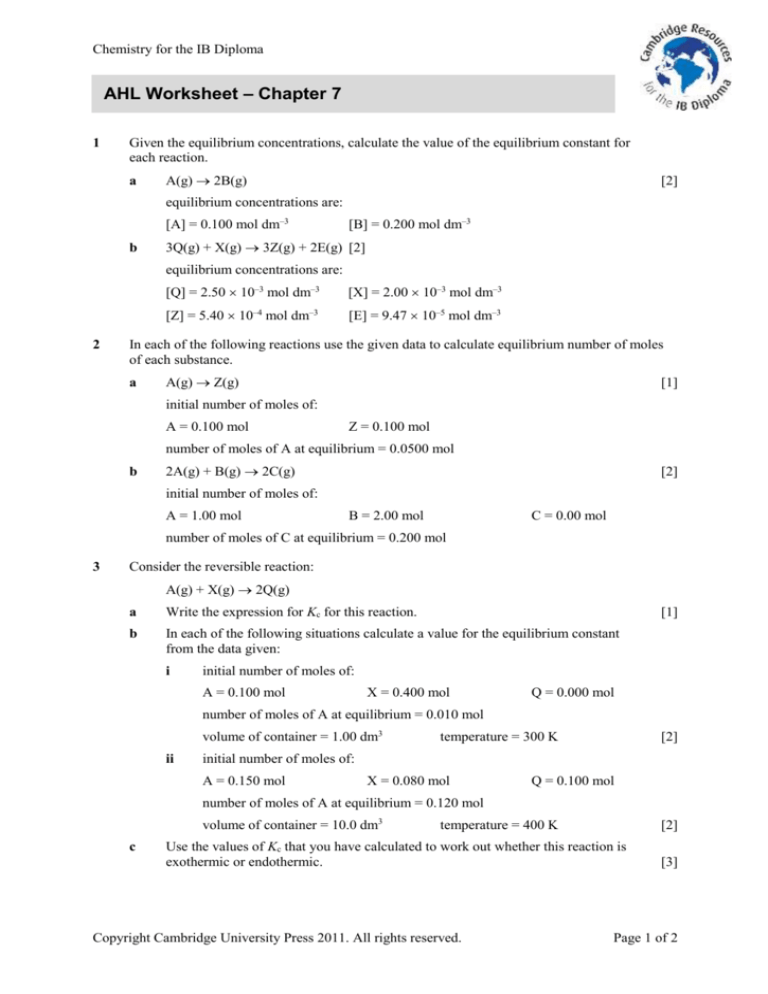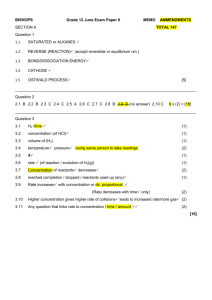
Chemistry for the IB Diploma
AHL Worksheet – Chapter 7
1
Given the equilibrium concentrations, calculate the value of the equilibrium constant for
each reaction.
a
A(g) 2B(g)
[2]
equilibrium concentrations are:
[A] = 0.100 mol dm–3
b
[B] = 0.200 mol dm–3
3Q(g) + X(g) 3Z(g) + 2E(g) [2]
equilibrium concentrations are:
2
[Q] = 2.50 10–3 mol dm–3
[X] = 2.00 10–3 mol dm–3
[Z] = 5.40 10–4 mol dm–3
[E] = 9.47 10–5 mol dm–3
In each of the following reactions use the given data to calculate equilibrium number of moles
of each substance.
a
A(g) Z(g)
[1]
initial number of moles of:
A = 0.100 mol
Z = 0.100 mol
number of moles of A at equilibrium = 0.0500 mol
b
2A(g) + B(g) 2C(g)
[2]
initial number of moles of:
A = 1.00 mol
B = 2.00 mol
C = 0.00 mol
number of moles of C at equilibrium = 0.200 mol
3
Consider the reversible reaction:
A(g) + X(g) 2Q(g)
a
Write the expression for Kc for this reaction.
b
In each of the following situations calculate a value for the equilibrium constant
from the data given:
i
[1]
initial number of moles of:
A = 0.100 mol
X = 0.400 mol
Q = 0.000 mol
number of moles of A at equilibrium = 0.010 mol
volume of container = 1.00 dm3
ii
temperature = 300 K
[2]
initial number of moles of:
A = 0.150 mol
X = 0.080 mol
Q = 0.100 mol
number of moles of A at equilibrium = 0.120 mol
volume of container = 10.0 dm3
c
temperature = 400 K
[2]
Use the values of Kc that you have calculated to work out whether this reaction is
exothermic or endothermic.
Copyright Cambridge University Press 2011. All rights reserved.
[3]
Page 1 of 2
Chemistry for the IB Diploma
4
Consider the reversible reaction:
2A(g) + X(g) 4Q(g) + Z(g)
a
Write the expression for Kc for this reaction.
[1]
b
Calculate a value for the equilibrium constant from the data given:
initial number of moles of:
A = 0.000 mol
X = 0.100 mol
Q = 2.000 mol
Z = 1.000 mol
number of moles of A at equilibrium = 0.800 mol
volume of container = 10.0 dm3
c
temperature = 300 K
[3]
Calculate a value for the equilibrium constant for the reaction:
4Q(g) + Z(g) 2A(g) + X(g)
at 300 K.
5
[2]
Consider the equilibrium:
A(g) + Z(g) X(g) + Q(g)
At a certain temperature the value of the equilibrium constant for this reaction is 4.00.
0.200 mol of A and 0.200 mol of Z are placed in a container of volume 1.00 dm3 and
allowed to come to equilibrium at this temperature. Calculate the number of moles of X
present at equilibrium.
6
[5]
The data in the table shows the variation of the vapour pressure of ethanol (CH3CH2OH)
with temperature.
Temperature / C
Vapour pressure / Pa
–31
133
–2
1330
19
5330
35
13300
64
53300
a
Draw a Lewis structure for ethanol.
[1]
b
Explain what is meant by vapour pressure.
[1]
c
Plot the data on a graph and use your graph to estimate the boiling point of ethanol.
[4]
d
Explain how the vapour pressure of ethanol at 0 C would compare with that of its
isomer methoxymethane (CH3OCH3) at the same temperature.
[3]
Copyright Cambridge University Press 2011. All rights reserved.
Page 2 of 2









